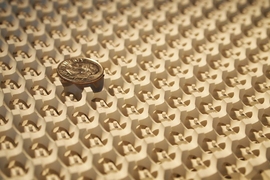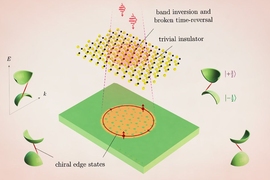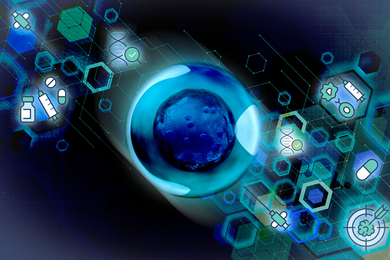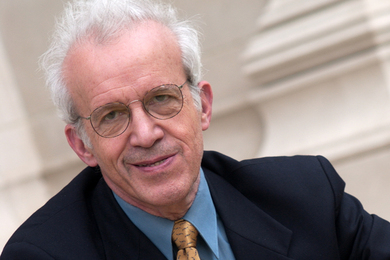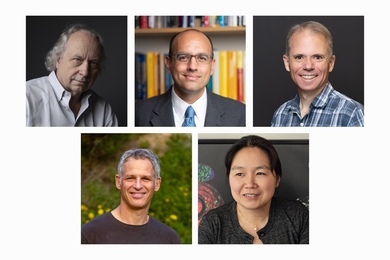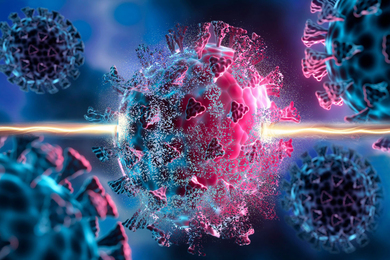Unlike classical computers in which a bit is either on or off, representing either a 0 or a 1, quantum computers will feature the extraordinary property of superposition, a state in which a bit can be both on and off, or both 0 and 1, at the same time.
MIT assistant professor of physics Liang Fu seeks to identify new materials that can process and store this quantum information robustly. His recent work presents a new understanding of how to couple the properties of superconducting materials, which show this superposition on a macroscopic scale, with new mathematical solutions for encoding data and protecting it against the inevitable errors in a physical system.
“I’m interested in quantum computation more from a materials perspective. Can we use new materials that are perhaps better suited for building a quantum computer?” Fu asks. “We sort of build a bridge between the abstract mathematics and, on the other hand, concrete materials, so we can apply the advanced tools of mathematics to study properties of materials and even predict new phases of matter with new properties,” Fu explains. “We hope that their new properties can be useful for device applications."
Fu frequently collaborates with experimentalists. “One of the things that makes condensed matter physics so fascinating to me is not only do we have concepts of fundamental importance, but also these concepts are not just like abstract theoretical ideas, but they really can be tested in experiments and some of my predictions have been experimentally observed. I personally feel it’s very exciting and very satisfying working in this mode. As theorists, we use paper and pencil to come up with ideas and then we can test it in the lab.”
Spin-triplet pairing confirmed
Fu’s prediction in 2010, while still a postdoc at Harvard University, that a particular electronic configuration known as a "spin-triplet pairing with odd parity" could be the basis for super conduction along the surface of the material bismuth selenide with a small amount of copper added was recently confirmed by Japanese experimentalists led by Guo-qing Zheng. These researchers used nuclear magnetic resonance, the same technology used for brain scans, to show the predicted topological superconductivity in copper-doped bismuth selenide. Super conduction is a state in which a material offers no resistance and electrons flow freely, which happens at extremely low temperatures, and in topological superconductivity, this property happens only along the surface of the material.
“We proposed a particular material, doped bismuth selenide, that might be a good candidate for a topological superconductor, and then many experimental groups tried to see whether it’s indeed topological or not. It sort of has taken a winding path,” Fu says. In most materials, electrons repel each other, but in these superconducting materials at very low temperatures, electrons join in what are called Cooper pairs. “Whether it’s topological or not relies crucially on the internal structure of the Cooper pair. So back then, for this particular material, we proposed that it may have certain types of internal symmetries for the Cooper pair. We listed all possible symmetries and we found that three out of four possible symmetries, if realized, will lead to a topological superconductor.” Since then, three separate experiments tested the theory with the first two producing conflicting results. “Now this nuclear magnetic resonance experiment has seen definitive evidence of a triplet Cooper pair,” Fu says.
“It turns out that these conducting properties are deeply related to some fundamental mathematical structure of their quantum wave functions, so that’s where topology comes in. Topology is a mathematical tool we use to study the quantum wave functions,” he explains.
New Horizons in Physics Prize
Fu was among a select group of young physicists honored with the 2016 New Horizons in Physics Prize, a $100,000 award presented during the Breakthrough Prize ceremonies in Mountain View, California, in November 2015. The New Horizons award recognizes promising junior researchers who have already produced important work in fundamental physics.
Quantum theory can confound everyday notions of reality, and the concept of superposition is perhaps one of the most challenging. Superposition says two electrons can occupy the same space at the same time in contrast to classical physics, which makes them mutually exclusive. The famous example of the Schrödinger’s cat dilemma proposes that a cat in a box can be dead and alive at the same time. Although it was first proposed as a thought experiment, laboratory experiments since have demonstrated macroscopic quantum states, or macroscopic quantum behavior. “It’s not just a thought experiment anymore. It’s a reality, quantum reality,” Fu says.
“Classically in the real world we will say the cat is either dead or alive, but a Schrödinger cat, it can be in a superposition between alive and dead. So that’s what the magic touch of quantum is all about,” Fu, explains. “In this century, a lot of what we are doing is trying to develop quantum technology based on these very complicated and weird concepts. That I think is going to require time. To some extent, a lot of the technology that we currently have, like lasers, for example, they are all based on weird quantum properties. All these are crucially linked to this weird quantum behavior. We are going to continue to explore more and more, for example, this weird superposition, entanglement, etc. I think it’s going to be quite exciting,” Fu predicts.
Screening out errors
In a recent paper with MIT physics graduate student Sagar Vijay and Timothy H. Hsieh PhD ’15, Fu proposed a physical basis for quantum encoding based on Majorana fermions, a special kind of electronic state that occurs in topological superconductors, and a mathematical method for screening out errors called a Majorana fermion surface code. Using the Schrödinger cat analogy, Fu explains: “The motivation for this Majorana code is any time you want to observe the cat, whether it’s alive or dead — even if you prepare the Schrödinger cat in a superposition between alive and dead — once you measure it, it’s either alive or dead. The quantum information is already lost. At the moment you observe it, the quantum information is gone.”
Fu first reported these Majorana states as a graduate student at the University of Pennsylvania under condensed matter physicist Charles Kane.
“No matter what physical platform we use to build quantum computers, there is always this profound challenge, which is on the one hand we want to preserve quantum information, we want to use it for information processing, on the other hand, either when we observe it intentionally or when the environment accidentally observes the quantum state, the quantum information is gone,” he says. This loss of the quantum state is called decoherence. “We have to come up with a way to fight against the decoherence process in order to keep quantum information alive as long as possible. Certainly during the duration of computation, we want to keep the quantum information intact.”
One approach to confronting this dilemma is this topological approach. “We want to find a macroscopic quantum system on which the information is protected in a topological way. Combining a topological superconductor with error correction approach, we think we have a robust platform for quantum information processing,” Fu says. Vijay and Hsieh developed a mathematical solution, which they call the Majorana surface code, for correcting errors in this system. “I have this very special type of system where if an error occurs on the qubit that I’m not measuring, then the measurements of the other qubits will tell me what sort of error has occurred,” Vijay says. (Hsieh is now a postdoc at the Kavli Institute for Theoretical Physics in Santa Barbara, California.)
Islands of superconducting rings
Information can be stored in a superconducting ring through which current can flow without energy loss for days or years. “In that case, the whole system, made of a huge number of electrons together, they are doing one and the same quantum behavior, doing the same thing together,” Fu explains. What makes it a quantum property is that supercurrent can flow in a superposition of both clockwise and counterclockwise. “That kind of a superpositioning is what we mean by quantum information. That kind of quantum information is actually stored in the flow of the supercurrent in a macroscopic observable. So that’s what I mean by a macroscopic state that encodes quantum information. This is an approach that I like a lot because it’s deeply tied with the study of materials.”
The Majorana fermion approach couples islands of superconducting rings in a honeycomb array on top of a topological insulator surface. A group of seven of these rings with six surrounding rings about a central ring is called a plaquette. Around each of these six-sided rings, at points where three rings share a common corner, electrons arrange themselves into pairs with up to four different possible configurations based on their spin, or direction of momentum, with the Majorana fermion holding the most promise for quantum computing. “The topological superconductor has these Majorana fermion excitations in it,” Fu says. “It’s a collective property of many electrons.” The article was published Dec. 10, 2015, in the online journal Physical Review X.
When he first understood the Majorana plaquette model, Fu says, he asked how it could be used. “We thought a lot about how to use this model, and eventually we realized it’s ideal for quantum error correction, for quantum information processing. That is a surprise. We didn’t realize it was so ideal before for this purpose,” he says.
“The system that we are interested in is a topological superconductor, so it has certain topological properties, and as a result, quantum information is protected to some extent against certain types of imperfections, certain types of decoherence process. But it is not enough. There are still other types of decoherence, which can destroy the quantum information encoded in topological superconductors, so to correct this second type of perturbation, we have to use error correction,” Fu explains.
Experimentalists at the University of Illinois at Urbana-Champaign are developing a device with superconducting islands deposited on top of topological insulators except that the array is made up of squares instead of hexagonal shapes, Fu notes.
Fu, who is 31, joined the physics faculty at MIT in 2012. He teaches an undergraduate class, 8.321 (Physics of Solids), which he says is often the first class where undergraduates are exposed to solutions that involve many approximations, which contrasts with the step-by-step, rigorous solutions in mechanics, for example. “The first time one is exposed to this kind of course, one might wonder naturally, with so many approximations, is there still anything reasonable you can say?” Fu explains, a question he asked himself as an undergraduate. “But, you know, it works. It works, and this is sort of the magic thing about solid-state physics, or generally condensed-matter physics, that because the system is so complex, we have to take approximations. We have to take approximations, but many of the collective behaviors of materials are robust. Despite all these approximations, as long as the key ingredients are kept, we can say something reasonable, and we can make great progress. I try to basically convey this to my students.”
Condensed-matter challenge
Unlike high-energy physics, where there is a single-minded focus on understanding fundamental particles and forces of which everything is made, Fu says, condensed-matter physics covers a wide range of efforts to understand the collective properties of materials. “To understand the macroscopic properties of materials, we are really not dealing with individual particles; we are dealing with the behavior that emerges when a tremendous number of particles interact with each other. That’s where the difficulty comes from. It’s a difficulty associated with complexity when many, many particles interact with each other. Even if we know the fundamental law that governs the interaction between two particles, it’s very hard to deduce the properties when many, many particles are simultaneously interacting with each other. So that’s the grand challenge of condensed-matter physics,” he explains.
“We find new material and then we think: How can we use this material? The time it takes from discovering a new material to finding an application for this material can be very long,” he suggests. Although aluminum was discovered in the 19th century, it initially was thought of as a substitute for silver. But only in the 20th century did aluminum find its ideal use in airplanes because it is very light. “It took more than 100 years to find a good use for something like aluminum,” he says. Similarly, materials like bismuth selenide and graphene may find very different uses in 50 years than envisioned today, he suggests.
Fu lives in Winchester with his wife, Mian Qin. They have two children, a son, 6, and a daughter, 3. Qin, who has a PhD in mechanical engineering, works for a company that makes numerical simulation software for computing electromagnetic waves and fluid dynamics. Fu enjoys reading, skiing, and playing with his children.



